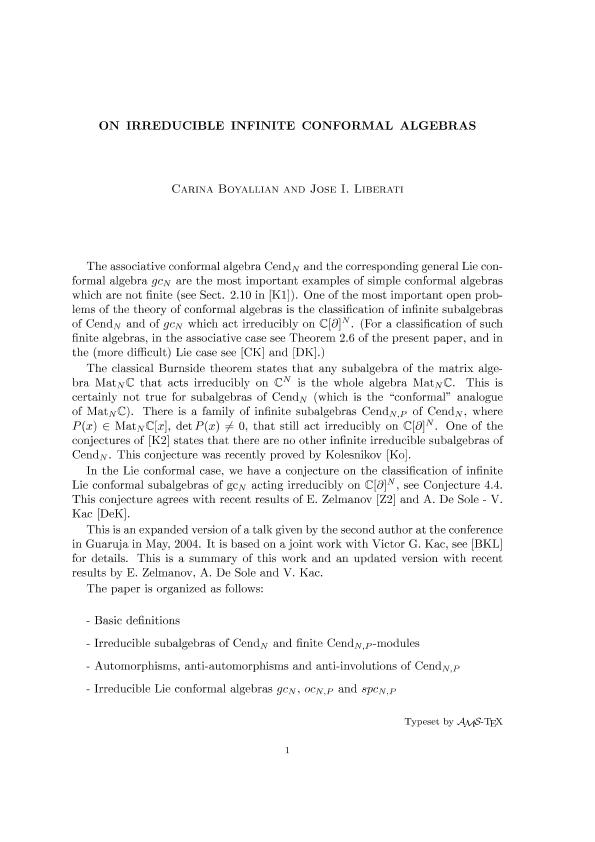Artículo
On irreducible infinite conformal algebras
Fecha de publicación:
12/2004
Editorial:
Universidade de São Paulo
Revista:
Resenhas Do Instituto de Matematica E Estatistica Da Universidade de Sao Paulo
ISSN:
0104-3854
Idioma:
Inglés
Tipo de recurso:
Artículo publicado
Clasificación temática:
Resumen
The associative conformal algebra CendN and the corresponding general Lie conformal algebra gcN are the most important examples of simple conformal algebras which are not finite (see Sect. 2.10 in [K1]). One of the most important open problems of the theory of conformal algebras is the classification of infinite subalgebras of CendN and of gcN which act irreducibly on C[∂] N . (For a classification of such finite algebras, in the associative case see Theorem 2.6 of the present paper, and in the (more difficult) Lie case see [CK] and [DK].) The classical Burnside theorem states that any subalgebra of the matrix algebra MatN C that acts irreducibly on C N is the whole algebra MatN C. This is certainly not true for subalgebras of CendN (which is the “conformal” analogue of MatN C). There is a family of infinite subalgebras CendN,P of CendN , where P(x) ∈ MatN C[x], det P(x) 6= 0, that still act irreducibly on C[∂] N . One of the conjectures of [K2] states that there are no other infinite irreducible subalgebras of CendN . This conjecture was recently proved by Kolesnikov [Ko]. In the Lie conformal case, we have a conjecture on the classification of infinite Lie conformal subalgebras of gcN acting irreducibly on C[∂] N , see Conjecture 4.4. This conjecture agrees with recent results of E. Zelmanov [Z2] and A. De Sole - V. Kac.
Palabras clave:
ALGEBRAS
,
IRREDUCIBLE INFINITE
Archivos asociados
Licencia
Identificadores
Colecciones
Articulos(CIEM)
Articulos de CENT.INV.Y ESTUDIOS DE MATEMATICA DE CORDOBA(P)
Articulos de CENT.INV.Y ESTUDIOS DE MATEMATICA DE CORDOBA(P)
Citación
Boyallian, Carina; Liberati, Jose Ignacio; On irreducible infinite conformal algebras; Universidade de São Paulo; Resenhas Do Instituto de Matematica E Estatistica Da Universidade de Sao Paulo; 6; 12-2004; 129-140
Compartir




